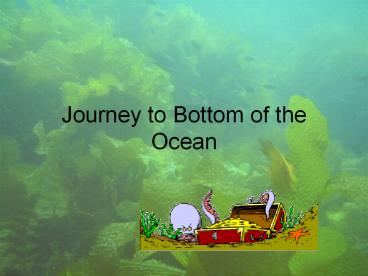Journey to Bottom of the Ocean - PowerPoint PPT Presentation
1 / 16
Title:
Journey to Bottom of the Ocean
Description:
Back to Map Compare continental and oceanic landforms Continental landform Canyon Valley Volcanic mountain Mountain Range Low hills or plains Oceanic landform ... – PowerPoint PPT presentation
Number of Views:393
Avg rating:3.0/5.0
Title: Journey to Bottom of the Ocean
1
Journey to Bottom of the Ocean
2
Continent
- Asia
- Africa
- North America
- South America
- Antarctica
- Europe
- Australia
- A continent is a large landmass.
- There are seven continents on the Earth
Back to Map
3
Click on a feature to go there or click next to
continue with the journey
Rift
4
We will begin our journey where land meets the
ocean.
Do you know where we are?
Yes. At the beach.
Beaches are the fastest changing part of the
ocean. They change with every wave.
Back to Map
5
Continental Shelf
- The edge of the continents slope down from the
shore into the ocean. The part of the continent
located under water is known as the Continental
Shelf.
- There are several part to the continental
shelf. - The continental break
- The continental slope
- The continental rise
The continental shelf is rich in resources such
as marine life, minerals and oil. For this
reason, countries around the world claim the
bordering continental shelf as part of their
territories.
Back to Map
6
Continental Slope
- The continental slope is a steep slope that
connects the continental- shelf to the bottom of
the ocean floor. The slope begins at a depth of
around 460 feet (140 meters).
Back to Map
7
Volcanic Island Arc
- Volcanic island arcs are a series of seamount
tall enough to break the sea surface and form an
island. - The Augustine Island Volcano in Alaska is an
example of a volcanic arc.
Back to Map
8
Abyss
- The deepest point in the ocean is called the
abyss - The Mariana Trench is the deepest known point in
the ocean. It is located in the western part of
the Pacific Ocean near the fourteen Mariana
Islands. - The Mariana Trench is a semi-circle that extends
from the northeast to the southwest for about two
thousand five hundred fifty meters and is seventy
kilometers wide.
Back to Map
9
Mid Ocean Ridge
- The mid ocean ridge is a series of mountain
ranges on the ocean floor. - They are more than 84,000 kilometers (52,000
miles) in length and they extend through the
North and South of the Atlantic ocean, the Indian
Ocean, and the South Pacific ocean. - According to the plate tectonics theory, volcanic
rock is added to the sea floor as the mid-ocean
ridge spreads apart.
Back to Map
10
Abyssal Plain
- Abyssal plains are the vast, flat,
sediment-covered areas of the deep ocean floor.
They are the flattest, most featureless areas on
Earth. These flat abyssal plains occur at depths
of over 6,500 ft (1,980 m) below sea level.
Back to Map
11
Seamount
- Seamounts are undersea volcanic mountains rising
from the bottom of the sea that do not break the
water's surface - Seamounts are usually isolated and cone-shaped,
often volcanic in origin. - Smaller volcanoes are called sea knolls, and
flat-topped seamounts are called guyots.
Back to Map
12
Guyot
- Guyots are seamounts that have built above sea
level. Over time erosion by waves destroyed the
top of the seamount resulting in a flattened
shape
The seamount becomes submerged to form a Guyot
Seamount rises above water
Erosion by waves flattens the top of the mount
Back to Map
13
Ocean Trench
- A deep-sea trench is a narrow, elongate, v-shaped
depression in the ocean floor. - Trenches are the deepest parts of the ocean, and
the lowest points on Earth. - They reach depths of nearly 7 mi (10 km) below
sea level. - They can be thousands of miles in length, yet as
little as 5 mi (8 km) in width.
Back to Map
14
Rift
- A rift valley is formed where two tectonic plates
pull apart from one another creating a deep
valley. - Rifts are the opposite of mountain ranges like
the Alps or the Himalayas where the plates push
together to create a mountain.
Back to Map
15
Compare continental and oceanic landforms
Continental landform Canyon Valley Volcanic
mountain Mountain Range Low hills or plains
Oceanic landform Trench Rift Seamount Mid-ocean
ridge Ocean basin (abyssal plains)
16
Sources
- http//www.utdallas.edu/pujana/oceans/guyot.html
- http//www.enotes.com/earth-science/abyssal-plains
- http//www.answers.com
- http//images.google.com/images?um1hlenrlz1T4
ADBF_enUS279US280qoceantrenchpictures - http//oceanexplorer.noaa.gov/explorations/02galap
agos/logs/jun04/jun04.html
Back to Map































